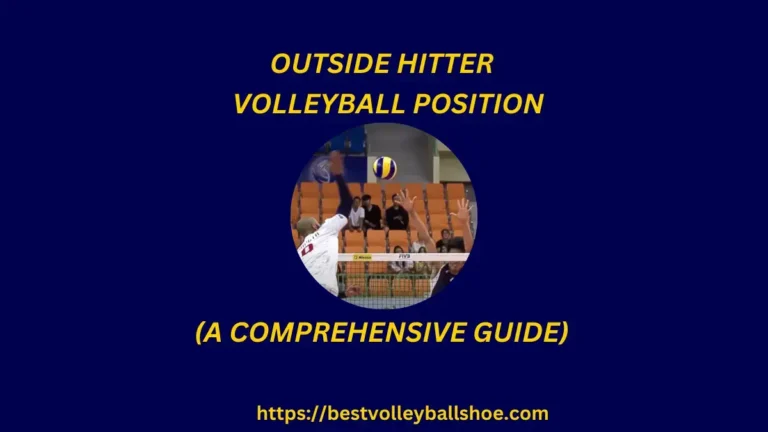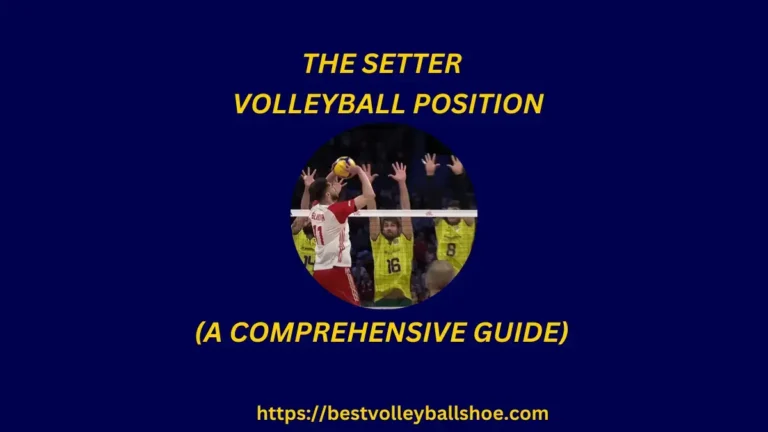Libero Volleyball Position: A Comprehensive Guide
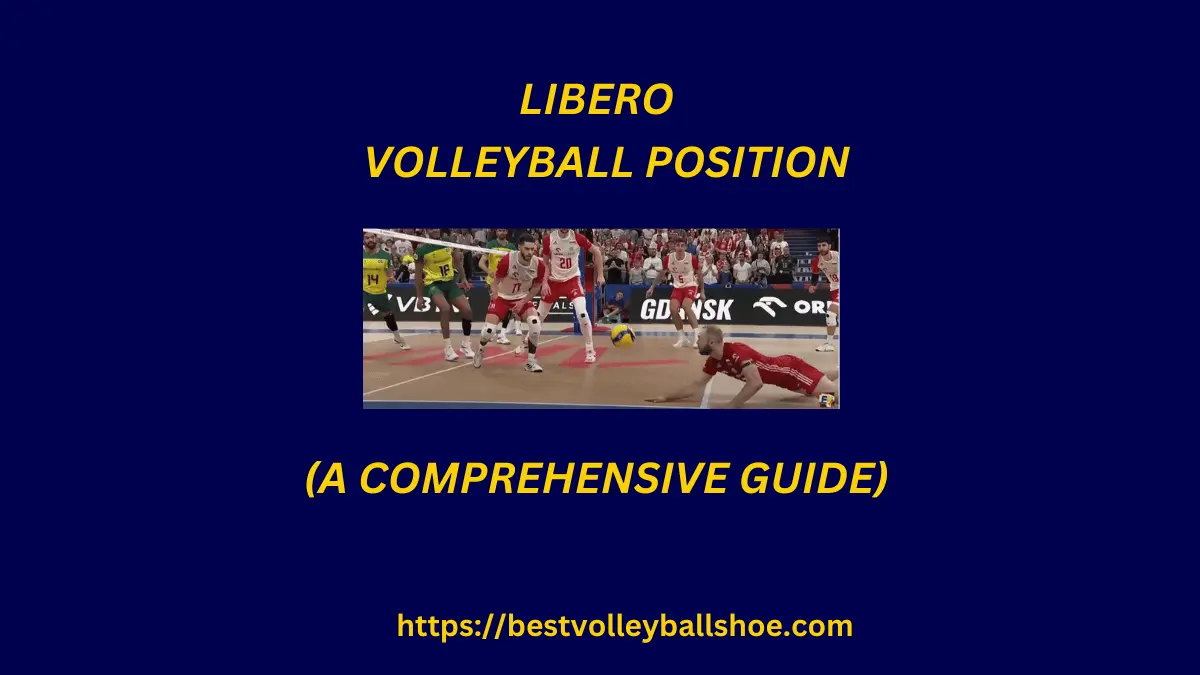
Libero volleyball is a position that specializes in defense. it’s a back-row player who can only be replaced by the same player it replaces according to NCAA rules.
They can sub in and out freely and their color jersey helps officials keep track of who the libero is. Libero has a remarkable ability to pass, dig, run to cover, and also has very fast reflexes.
In this article, we will discuss different basics of this playing position, including volleyball terms, history, volleyball rules, playing position, rotation, role, importance, qualities, physical attributes, and most importantly best volleyball shoes for this position.
Finally, we will evaluate the recruitment standards and important tips for becoming a better libero.
So let’s start without any delay!
What is a Libero in Volleyball?
”libero” is an Italian word that means free in Italian that meant, liberos were “free” not to follow the traditional rules of volleyball for rotation and substitution and they could come in and out of the game with few limitations.
Although the designated libero had a lot of freedom in the back row to roam anywhere behind the ten-foot line, they were actually prohibited from becoming a spiker who could hit the ball in the front row.
Terms for Libero Volleyball
A few other terms are also used in volleyball commentary, analysis, and media coverage. These terms are mainly used to describe the role, impact, and understanding of liberos skills and importance.
History & Evolution of Volleyball Libero
Background
The concept of the libero volleyball position was initially introduced in Italy during the late 1980s and early 1990s. This was established simultaneously with a new rally point scoring system to enhance the pace of matches, and aimed to contribute to longer and more exhilarating rallies.
Following its international acceptance, the libero position was integrated into NCAA women’s volleyball in 2002.
Speculation arose that the libero position was introduced to provide players of shorter stature with a more prominent role in the game, despite the absence of height requirements in the rule.
Primarily, liberos were positioned strategically to cover attackers, aiding in preventing blocked balls from the opponent from hitting the floor.
In his editorial called ‘Revolution by the show’, André Glaive, then French National Technical Director, predicted that:
Evolution
Initially, the libero’s role was essentially that of a specialized defensive specialist. They did not assume responsibilities beyond what a typical defensive specialist would.
However, Over time, the notable shift in the utilization of liberos is becoming more evident. Today, liberos are entrusted with the crucial role of setting the second ball when the setter is required to dig.
This transformation can be attributed to various factors, including an increased focus on targeting setters defensively, the elevated role of opposite hitters in the offense, and a more conservative approach to digging targets.
Their central position on the court enables them to direct the ball to various attacking options, adding a new layer of versatility to their role. This shift in responsibilities has led to a transformation in the requirements for the libero position.
Beyond defensive prowess, proficient setting skills are now becoming essential, prompting coaches to recruit experienced setters for the role.
The leadership factor adds an extra dimension to the position’s importance. In identifying and training prospective liberos, coaches must consider these evolving dynamics.
Volleyball Rules for the Libero
Libero Volleyball Playing Position, Rotation, and Substitution in the Court
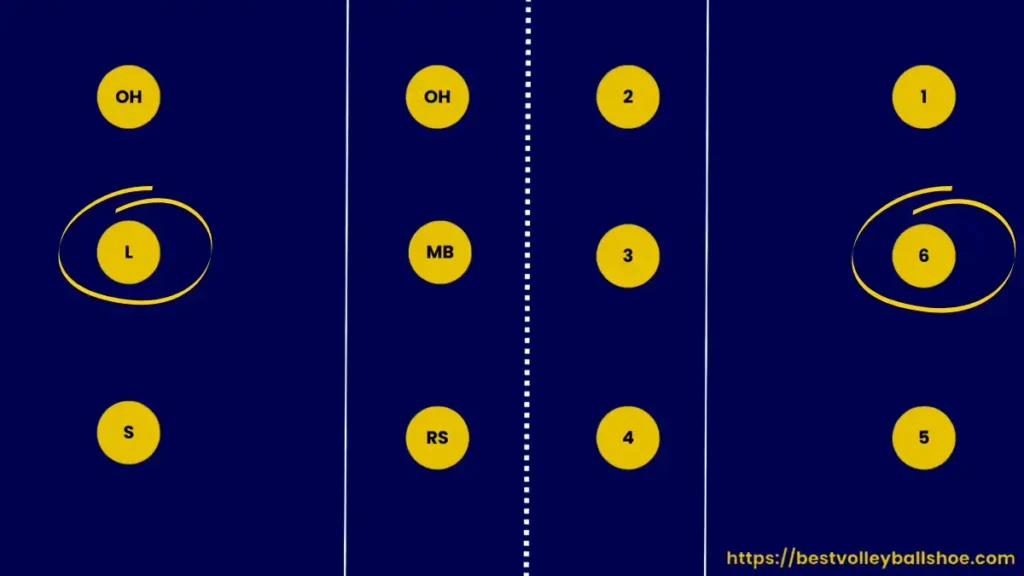
Role of the Libero Volleyball Position
Qualities/Strengths of the Best Libero
1. Speed and Explosiveness
Geat Liberos are like the Usain Bolt of the volleyball court. It’s like they’ve got a secret turbo mode that they activate to cover ground faster than you can say “spike!”
When that ball is up in the air, they’re already on their way, moving with a speed that makes us wonder if they’ve got a pair of rocket boosters hidden in their shoes.
It’s not just about getting there; it’s about getting there before anyone even realizes the ball is in play.
Great liberos
It’s like they’ve got a secret turbo mode that they activate to cover ground faster than you can say “spike!”
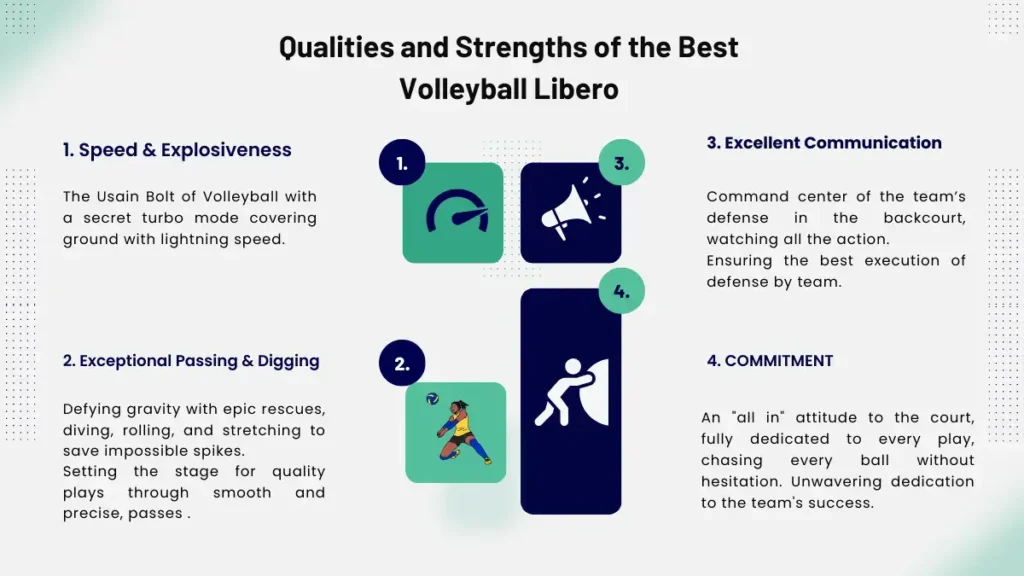
2. Outstanding Digging and Passing
Passing and digging are the two basic skills for a libero and the great liberos are simply exceptional in these skills. Just Imagine! A powerful spike comes over the net, and just when you’re ready to accept defeat, the libero swoops in like a wizard and digs a nearly impossible ball.
When it comes to digging, they dive, roll, and stretch to save that ball from hitting the floor. Their saves are more like epic rescues, defying gravity with style.
The best libero pass is like a magic trick—smooth and precise, delivering the ball right where it needs to be. Accuracy of the pass decides the quality of the set excluding the ability and skill of the setter.
3. Excellent Communication
Imagine the libero as the “command central” of the team’s defense. Positioned in the backcourt, they have a clear view of the court and can see the ball’s every move. It’s like having a watchful eye on all the action.
From this vantage point, they communicate like a seasoned conductor, guiding their teammates’ movements based on what they see. Their shouts aren’t just noise; they’re a game plan in action.
Digging and passing are the primary roles of liberos, and they often manage this role through effective communication. For example, when a libero can’t reach a ball, they might call upon the nearest player to make the pass or dig.
Conversely, if the libero is in a good position, he might instruct his teammates to leave the ball for them. It’s all about quick decision-making and clear communication, ensuring that the team can execute the best possible play in any situation.
4. Commitment
Imagine you’re in the middle of a volleyball game, and a ball drops between you and your teammate. But instead of both of you going for it, you hesitate, thinking the other will handle it. It’s like a missed opportunity that can cost your team points.
But not for dedicated liberos. They bring a different mindset to the court – an “all in” attitude. This means they’re fully committed to every play, no matter what. They don’t hold back or second-guess themselves. When a ball drops, they charge after it without hesitation, and considering the bruise or pain but giving it their all.
This kind of commitment is like a secret weapon for liberos. It keeps things clear and avoids confusion. Every ball gets the attention it deserves because they’re fully invested in the game. So, when you see a libero diving for a ball, remember that it’s not just about skills, it’s about their unwavering commitment to the team’s success.
Physical Attributes of a Libero Volleyball
1. Height
An important and one of the distinguishing physical features of a libero. Usually, he is the shortest player on the team.
This makes sense, as a taller player will take a bit longer to bend and move quickly compared to a shorter one.
For instance, 167 cm tall Iranian libero Farhad Zarif will take less time to band as compared to 218 cm tall Russian middle Dmitriy Muserskiy
Primarily, a libero has to dig more than any other player, so he has to do quick movements and short height facilitates his quick movements.
You can see the graph of height comparison among different volleyball players both men and women.
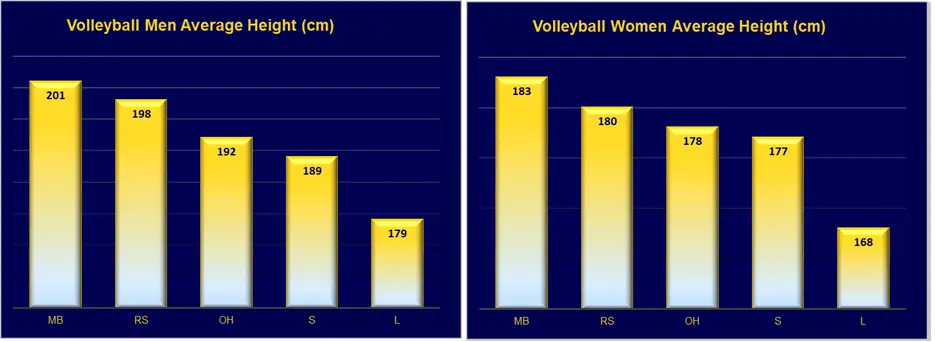
2. Quickness
Agility and quickness are important for speedy movements and direction changes to dig or pass the ball in time and efficiently. In short, It’s not just about reaching there; it’s about getting there before anyone even notices the ball is in play.
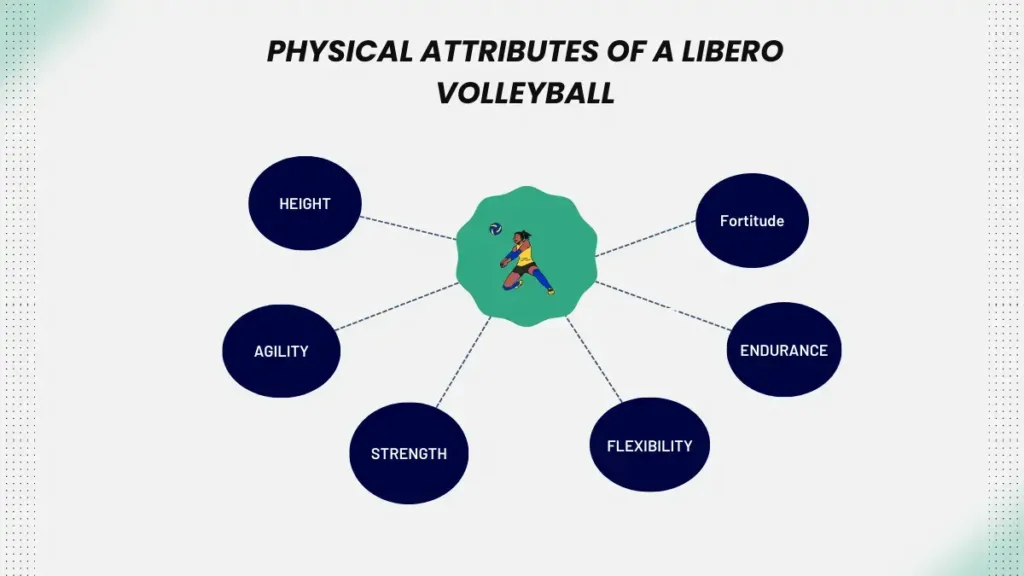
3. Body Strength
A libero must have a strong upper and lower body to fulfill the game requirements. Strong legs are especially important to make quick movements like diving to reach and dig the ball.
4. Flexibility
Flexibilty is imperative to avoid injuries while carrying out difficult movements for difficult digs. I will suggest watching the videos of Poland team libero Pawel Zatroski to better understand this word.
5. Endurance
to meet the game requirements and achieve the highest performance.
6. Fortitude
Mental strength is very important To handle the pressure situation and maintain consistency.
Is Libero A Good Position to Play In Volleyball?
There are a few checklists and other aspects to keep in mind while deciding this.
Firstly, what is your interest, if you like to challenge the spiker who powerfully hits the ball into the opponent’s side of the court, and you enjoy the movement of frustration after digging his hit? Then of course! you should opt for this position. On the other hand, if you like to free your arm by spiking and hitting then this position is not for you
Secondly, what is your height, standing reach and jumping reach? If you’re a shorter athlete with low standing and jumping reach then you should also opt for this position.
Thirdly, it depends on why you are playing volleyball. If for enjoyment then it’s ok to choose this position. On the other hand, if you want to be a professional and also meet/fulfill the height and reach criteria of other volleyball positions then “absolutely no”.
Me following are the reasons for this:
As a Libero, you can still win contracts and earn well, but you need exceptional skills to stand out.
Recruitment of Liberos at Collegiate
I have briefly described various aspects of the libero volleyball position above covering introduction, history, rules, role and responsibilities, qualities, and physical attributes.
All the above information covers basic information and the objective is to briefly describe to our readers the ABC of the libero in volleyball.
Now, I have moved a step further for those who are looking for a volleyball career and wanna get selected as a volleyball libero at the collegiate level in the USA. Here are the various requirements of this position as per NCSA.
According to the NCSA, the recruitment standards for the women liberos are given in the graph. The prime factors for recruitment include height, standing Reach, Attack jump, block Jump, vertical Jump, and experience.
Recruitment Guidelines for Women
As per guidelines the average height for the libero at the college level in the USA is 167.64 cm, standing to reach 213.36 cm, attack jump 259.08, block jump 254.508 and 557.784 cm
As regards the experience, a woman libero should have open-level playing club experience. This is to gauge the knowledge of the game and position.
Rest aside from my previous professional volleyball career, I won’t consider these stats very important for Libero volleyball even as a spectator.
The vertical jump has nothing to do with the libero, so I’ll say that if you are a good passer and digger you can be there without this much high verticle jump.
Recruitment Guidelines for Men
The detailed recruitment guidelines for men’s libero volleyball aren’t formally published by NCSA. However, the few stats data that are available include height and experience.
Height: Depending on various playing levels and divisions of NCSA the average height for a volleyball player is between 5’8” to 6’2’’’. This data shows that the liberos volleyball are the shortest players on the court.
I will consider this height as rational as most of the liberos in the world aren’t very tall. like Pawel Zatroksi of Poland and Erik Shoji of the United States are 6′.0” in height.
Experience: Depending on the level and division, you should have an average of 2-5 years of elite and national club experience.
Essential Equipment for a Libero Position
Volleyball Shoes
An important and basic volleyball equipment for any volleyball player is volleyball shoes because your feet are the first contributor to your sprints and dives.
Every player should choose the best volleyball shoes available in the market. For the libero, I’ll recommend addidas stable next-generation

Adidas Stable Next Generation
Available in various colors, and cool looks. Supportive in lateral movement. A good option for the liberos being close to the ground.
Mizuno Volleyball Kneepads
How To Be A Better Libero?
Every beginner in any field of life has a built-in desire to excel in his career and a similar case is with a beginner volleyball libero. In fact, to be in search of a better position in the future is a very good sign.
First of all, recall the qualities of the best libero that I have mentioned at the start of this article. More or less same are the tips for becoming a better libero. However, I have also written a detailed article regarding tips and tricks for becoming a better libero.
Passing and Digging Techniques
Think of these two skills as your foundation – they’re like the bread and butter of being an exceptional libero. These skills will be with you throughout your career as a volleyball libero.
When it comes to passing, I’m talking about passing the ball to your setter with pinpoint accuracy.
You should create a solid platform with your forearms by clasping your hands together, forming a kind of flat surface.
The ball should bounce off smoothly to the setter after hitting this solid platform. This can only come after great practice. So I’ll suggest spending your quality time practicing the pass.
As regards the digging which is an art of getting under the spiked balls and sending them back into play. It’s like being a ninja with a volleyball! To do this, you’ve got to read the ball’s trajectory like a pro.
I’ll suggest you, keenly observe the hitter’s approach and make a quick decision on where to position yourself. Once your quick reflexes kick in – dive, roll, or slide – do whatever it takes to pop that ball back up and keep the rally alive.
Develop Quickness, strength & explosiveness
As stated earlier the best liberos are like they’ve got a secret turbo mode whose activation enables the libero to to cover ground faster than spike.
You have to develop this turbo mode.
If you are getting lazy on the court then think of the merciless spike from the opponent hitter. You have to decide and act in a milli seconds. The only way to accomplish this uphill task is to develop agility and explosiveness.
It is noteworthy, that you should be strong in your lower body to do sprints and dives.
Practice Makes a Man Perfect:
I want you to remember the above sentence. A coach or a mentor can teach you the technique but he can’t bring your skill to perfection.
It’s only you who have to work hard to let it happen through your dedication and hard work
FAQs for Liberos Volleyball Position
Can a Libero serve?
A libero can serve in the US at different playing levels from school to college, but the FIVB rules do not allow a libero to serve.
Are Libero and DS the same?
Libero and defensive specialists are the same as far as the defensive role is concerned. However, a defensive specialist is not a specific position as of libero. In fact, it is an additional skill of any volleyball player regardless of his position.


